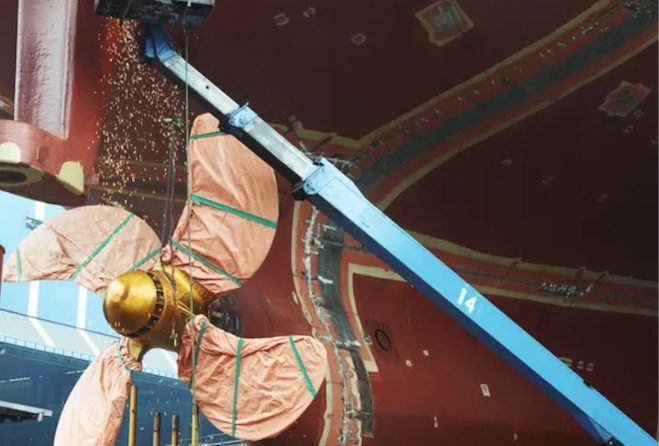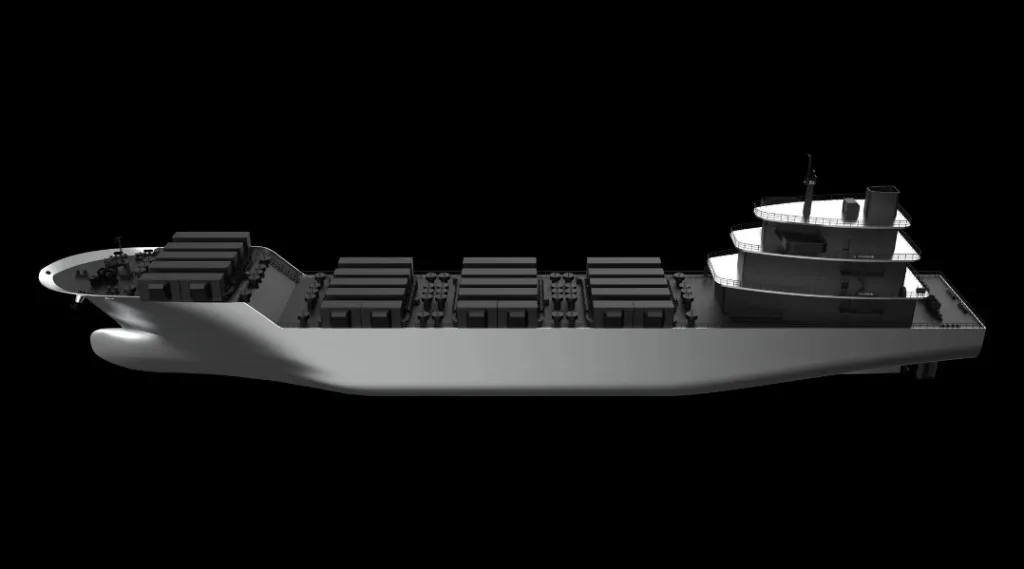28 November 2024
Retrofit vs newbuild? 45% of ships today will not comply

Demand for replacement ships is building as owners face more carbon regulations targeting older, less efficient ships. But the options are daunting; is it wiser to retrofit an existing vessel to improve its carbon ratings, or replace it with a new one?
Table of Contents
Concept
According to the Program Manager of LR’s Maritime Decarbonisation Hub, Charles Haskell, the reality is that no ship can be fully future-proofed yet because the marine fuels of the future are still under development and there are few rules, designs, or builders, no crews, and no managers for the ships of tomorrow.
Perhaps most importantly from a Class point of view, there are no safety frameworks yet, though Haskell and his team are engaged in an ammonia-for-fuel project. It is focusing on a detailed quantitative safety risk assessment spanning several industrial sectors, outside shipping, over several decades.
But the reality is that ship designers cannot even offer blueprints yet; shipbuilders don’t know what materials will be required; repairers have no experience with new fuel technologies; ships’ crews are not trained to handle new fuels or operate ships that use them; and shipowners’ land-based staff, including experienced superintendents, will need to learn about new fuel supply systems, storage, and combustion technologies.
Haskell refers to the Maritime Just Transition Task Force, set up during COP26, which has concluded that no fewer than 800,000 seafarers will need to be trained by 2030.
Three decades of retrofits
Haskell has clear views on the question of retrofit or replacement. He points to the analysis from The Silk Alliance, an initiative that has developed a future fuel framework to enable the setting up of a scalable green corridor cluster. Their analysis has revealed that quite apart from existing ships, 20-30% of those that are built in the years ahead will need to undergo retrofits before 2050.
Hence, the challenge facing owners and operators today is not only what to do with existing ships, especially younger ones; it is also how to ensure that ships designed and built in the balance of this decade can be retrofitted effectively and economically before the middle of the century.
“There is now a realisation that the clock is ticking. We have moved on from theory; two years ago, they were asking ‘what is ammonia, what is methanol?’
“Our clients realise that they need a technical understanding of what is coming and to understand the technologies and how they work, how crews can be prepared, and how ships may be designed and operated. They certainly need to know that there will be an acceptable return on investment. And they realise that collaboration with charterers is essential.”
“We estimate that at least 45% of ships today will not be compliant with carbon intensity regulations in three years’ time.”
Nikos Tsatsaros, New Constructions Sales Director, Lloyd’s Register

Is Retrofit a future-proof solution for your fleet?
As new sustainability and safety standards come into force around the world, ship owners must consider retrofit the swift and cost-efficient option.
Ship Nerd
Complex charter negotiations
Tsatsaros reveals that charter negotiations on new ships are growing in complexity. For owners, adopting new technologies is about investment returns and therefore close attention is required to clauses in the charter party agreement relating to ship performance. On new projects that are under development, some charterers are proving to be supportive, while others are not. More collaboration is required.
“Charterers’ strategies vary and some say that extra costs are for an owners’ account. Others are more realistic If the cost of providing the service goes up, the charterer will have to pay more. I think charterers’ views are softening. It’s a matter of collaboration between different stakeholders.”
Nikos Tsatsaros, New Constructions Sales Director, Lloyd’s Register
Retrofits on younger ships often make good sense, but options become limited on older vessels where significant capital investment won’t pay back over the vessel’s operational lifespan. Meanwhile, some new technologies cannot be installed on existing ships and the cost of a retrofit could actually work out to be more expensive.

Importance of SEEMP & Collaboration in Meeting CII Requirements
Shipowners should focus on SEEMP, and work in close collaboration with charterers, the industry may be off to a good start for the CII framework.
Ship Nerd
Tsatsaros also stresses the broad range of owners and their access to resources. The industry’s leading pioneers, such as major container lines, have sufficient muscle to test new fuels on their own, but most shipowners lack the resources for this.
“Smaller owners want advice on available options, techno-economic guidance, and involvement in joint development projects.”
“When owners have understood the new technologies that are likely to become available, they are asking how ships can be made ready today for economically viable modifications tomorrow. ”
Nikos Tsatsaros, New Constructions Sales Director, Lloyd’s Register
– Are there enough shipyards?
“This last question is important from a retrofit perspective. If there are no newbuilding slots available, then retrofitting older ships may be the only option. If there is a proper cost analysis and a good charterparty where the charterer is willing to share the cost, then you have an asset with another ten years of viable operation. However, my concern is that charterers may not yet be ready to support retrofit projects.”
Nikos Tsatsaros, New Constructions Sales Director, Lloyd’s Register
Facing the feeder challenge
Some ship sectors are more vulnerable than others to the impacts of tighter carbon regulations. The feeder container ship segment is one. Why many owners of these ships are in a quandary? Should they retrofit existing vessels or should they build new ones?
Feeders fulfill an essential function in completing the ‘last mile’ of a container’s journey. Vessels are usually deployed on relatively short voyages from hub ports to secondary terminals, with frequent port calls. Experts predict that many ships in the sector are likely to be rated in the two lowest categories of the IMO’s Carbon Intensity Indicator – D and E.
The feeder fleet consists of many small older vessels with relatively poor fuel performance and limited speed flexibility. Many sail relatively slowly, leaving a slim margin for bad weather or congestion, and are therefore poorly placed to benefit from some energy-saving technologies. Harnessing the power of the wind, for example, would be a tough task; these ships are in and out of port all the time.
Freight rates are relatively static and are often the subject of fierce negotiations between service operators and their customers. Achieving a satisfactory return on investment in a carbon-cutting strategy could well prove a challenge.
Nick Gross (Global Containerships Segment Director, LR) points out that there are, as yet, no correction factors in place to compensate for the nature of feeder operations. Nor are there likely to be any until the second half of this decade and feeders will not be at the top of the list of ship types requiring such adjustments when the time comes.
So what is the case for replacement? Well, many shipyards are full and feeder vessel construction is relatively unattractive. Even if an owner found a suitable yard and an acceptable price for a new feeder with energy-saving features, could they be sure that rates would generate an acceptable return?
There are exceptions, of course. Gross highlights a project in which LR is an advisor to China Classification Society in the design of a feeder, powered solely by batteries for operation on the Yangtze. But such an arrangement would not work on feeder trades at sea, he says, because of battery management considerations.
Meanwhile, although major shippers are focusing on carbon efficiency on ocean voyages, the final leg of a journey is a secondary concern. For smaller shippers, with just a few boxes a week or month, carbon efficiency and ESG issues are far down their list of priorities.
So the challenge of ‘future-proofing’ is daunting. Gross insists, however, that the statistics are compelling. Many older feeders will need replacing soon. And, although retrofits may not make much sense, building new ships at this time may not stack up either.
Source: LR
See Also
PowerX, Inc. (Head Office: Minato City, Tokyo, Japan; Director, President & CEO: Masahiro Ito, hereafter PowerX) has unveiled the detailed design of the first-ever ‘Battery Tanker’ at the ‘Bariship’ International Maritime Exhibition held in Imabari City, Ehime Prefecture, Japan. The inaugural ship “X” aims for completion by 2025, with domestic and international field testing planned to commence in 2026.

The world’s first battery tanker design – New release
Japanese power transfer vessel developer PowerX has unveiled the detailed design of the first-ever ‘battery tanker’ set for domestic and international field testing in 2026.


